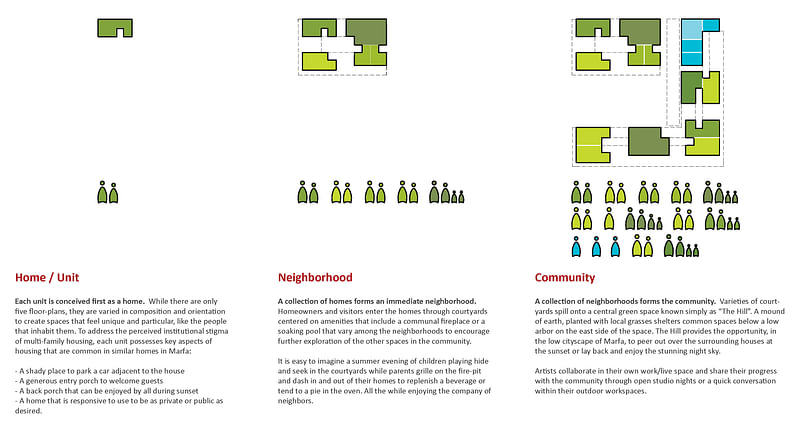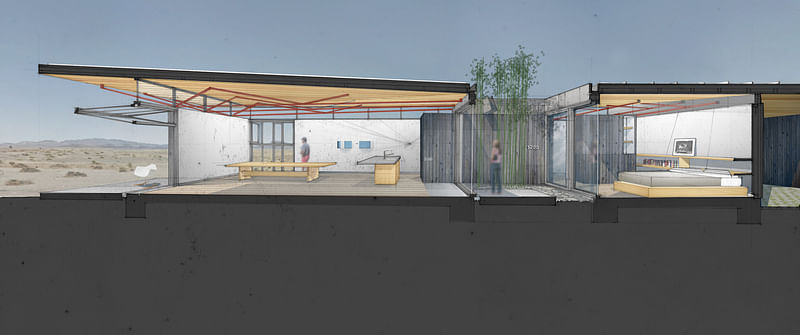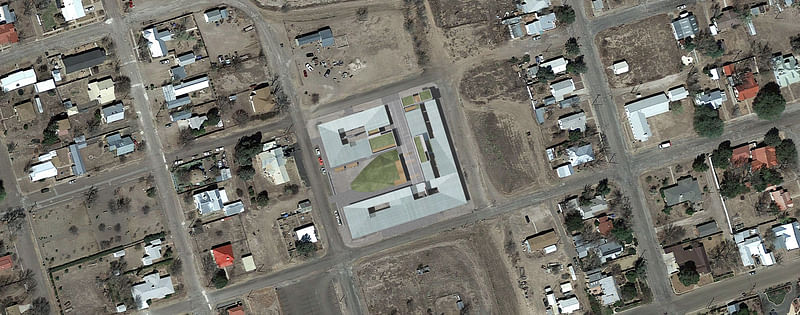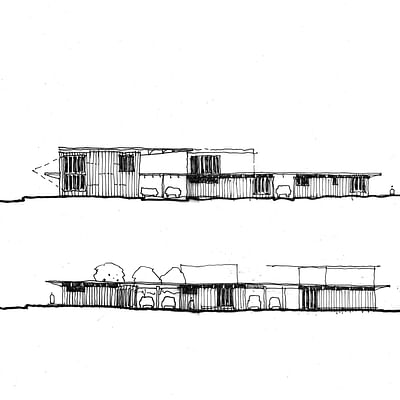Details behind Studio Modh's finalist Design Marfa Housing proposal
By Bustler Editors|
Monday, Feb 9, 2015

Related
Studio Modh Architecture of Brooklyn, NY was one of the five finalists in Design Marfa's Multi-Family Housing Competition for the town of Marfa, Texas. Located in the Chihuahuan desert and with a population of approximately 2,000, growing tourism in Marfa has made the need for full-time resident multi-family housing even greater.
So Design Marfa set up an open competition to find new housing design solutions. A total of 135 teams from 17 states and 14 countries sent their ideas to the competition.
Have a look at Studio Modh Architecture's proposal below.
Project description:
"INTRODUCTION: Marfa House is a community of neighborhoods formed under one roof. The design evokes the long, low slung industrial buildings that dot the vast Texas landscape and places is it at scale with the surrounding community. Deep recesses, courtyards, and a generous green space break the scale down at the curb to feel more residential.
The neighborhoods are created by the physical and social connections of the homes and inhabitants within it. Each neighborhood coalesces around a small courtyard that provides a sheltered green space and a gracious entry to each home. Neighborhoods then spill onto a shared green space that rises eleven feet to the level of the roof to capture the far off desert landscape.
Each home is an expression of how contemporary Marfa can develop. The car is embraced, but controlled, as a vital tool of living in the west. Generous rooms blend together to share in the abundance of in-direct light that peels across the wood ceilings of the spaces. The exterior is accessed through select, full wall folding glass doors or courtyards that draw light and air into the center of each home.
The design is a careful assembly of the physical qualities that make Marfa unique and the new social dynamics that draw people to Marfa – largely provoked by the creative developments of Donald Judd and the Chinati Foundation. It is not a hyper-dense urban assembly, but it is also not a building that fills the land needlessly or without criticality. It is a response to the need for Marfa to embrace all aspects of its ever-changing community, to seek more sustainable and environmental uses for its resources, and to balance this with maintaining the character that draw people and ideas to Marfa."

"UNITS: Multi-family housing projects are known for monotonous, repetitive floor-plans that create spaces that possess an institutional quality that belies the sense of comfort that comes from the freedom to shape ones own home. In order to balance the desired individuation of units with the economies required to make the construction of multi-family practical from both an initial construction and monthly rent standpoint, the plan lays out a series of repetitive units in different relationships to each other to create “neighborhoods” of 3-5 units. There are five total neighborhoods that create a total maximum population of 42 tenants across 15 total units.
Each unit has been designed to accommodate a different type of occupancy including:
- Type A and B – A young couple or individual professional - 7 units, 14 persons max.
- Type C – Family Home - 2 units, 8-10 persons max.
- Type D and E – Starter Home - 3 units, 9-12 persons max.
- Artist Collective - 3 live/work units - 3-6 persons max. (if spouse/partner lived with artist)"

"ZONING: The Marfa House design strikes a balance between the identity and accessibility of the typical single family homes in the area and the efficiency and density of multi-family housing. The design addresses the requirements of the Marfa Multi-Family and Residential Code provided as part of the competition.
Front Setbacks: These have been assumed on all four sides of the block as the project sees the building as a full block, four frontage building. Setbacks are 25’ as required to face of building.
Building Separation / Side Yard: Separations between buildings are a minimum of 15’ and windowless. Courtyards or alcoves are accessible off of these separations and have windows that are perpendicular to the yard. But in all cases a min. of 15’ (and typically 30’) from adjacent buildings.
Rear Yard: There are no rear yards as the building fills the site and does not sit adjacent to another lot.
Lot Coverage: Not including the courtyards within each 'Neighborhood' or parking courts between units, the open area is 38,992 SF or 55% of the total area of the property, exceeding the 40% requirement in the code."
Unit Sizes: Each unit meets or exceeds square footage requirements of the code based on the bedroom quantity.
Height: The building is 11’0” tall along the one story volumes and 22’0” tall at the two story volumes."

"SUSTAINABILITY: Sustainable strategies are integrated into every aspect of the design from planning to material selection. The goal is to create a building that is of the place (local materials, labor, support), energy efficient, and long lasting to obviate replacement costs. Like any architectural project, sustainable strategies are presented in balance with function, economy, and schedule and would be honed through a qualitative and quantitative assessment with the end users, clients, and local contractors.
Place: The design employs common building techniques that enable it to rely on local tradesman and readily available materials that can be sustain-ably harvested. This includes the wood cladding, wood framing, flooring, and ceiling materials. As an alternative to a site built scheme, the design’s standardized planning (repetitive plan types) would enable the walls and wet cores of the building project be fabricated off-site at a “Flat-pak” type housing manufacturer, shipped to the site, and erected to the design specifications and drawings...
Energy Efficiency: The building is designed with minimal quantities of glazing and in all but a very few cases, glazing that is only under significant shade formed by deep roof overhangs. This design insures only in-direct light enters the housing eliminating the significant heat load during the daytime periods.
Materials / Longevity: Materials are selected based on their naturally renewable and performing characteristics. Wood siding is treated using the Japanese 'Shou Sugi Ban' burning technique. This creates a more durable and fire resistive surface that can be site treated or done in a factory. Windows would be thermally broken steel windows with insulated glass units to insure thermal performance and long term weathering capability in the desert.
Landscape: The landscape is designed to require minimal amounts of water to maintain. Most of the landscape would be a trap rock gravel to insure good drainage, interspersed with natural grasses. Interior courtyards would be watered via roof water that naturally pitches and collects at a scupper in these spaces. All walking and driving surfaces would utilize a permeable paver system to insure good water management and decreased heat absorption impact."

"ECONOMY: The issue of economy encompasses the cost to build or install, the cost to maintain, and the replacement costs. This is also known as the Life Cycle Cost. The design form, detailing techniques, materials, and methods of construction are based on being able to construct using locally sourced material and labor, and in the absence of that for economic or practical reasons - be able to fabricate and rail or truck ship from within a reasonable distance using a pre-fabrication company and the “flat-pack” method of fabrication and shipping. Tight layout of core plumbing, mechanical, and electrical components will insure minimal plumbing costs and a centralized connection to the mains running to municipal infrastructure. Knowledge of the local building trades is not known and thus an accurate cost per square foot would be a guess without any substantive input from a trade professional..."
For the full project description, click here.






Share
0 Comments
Comment as :